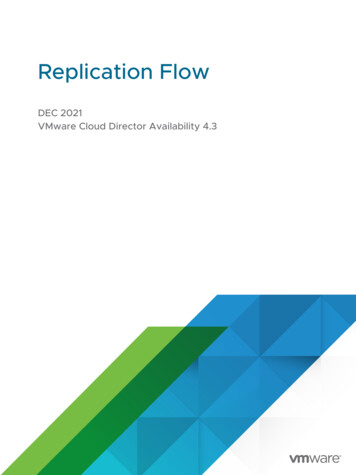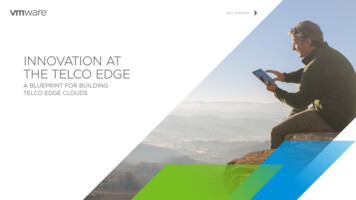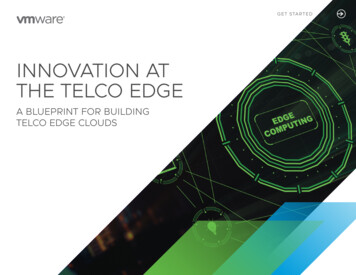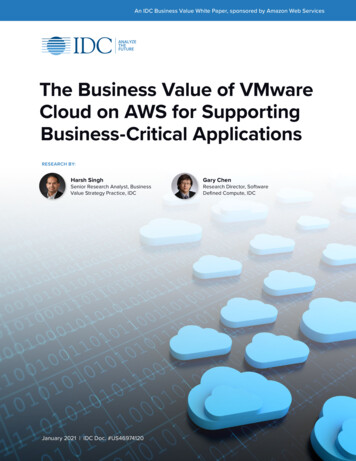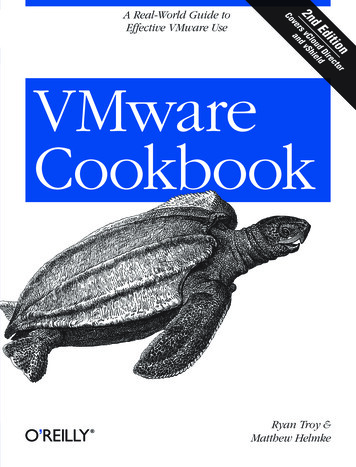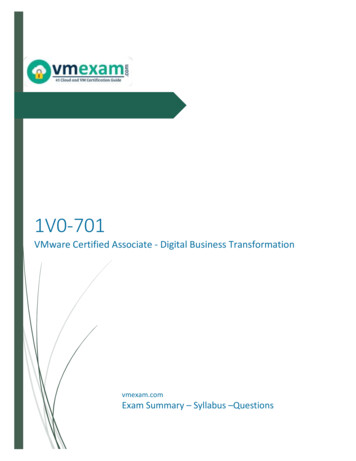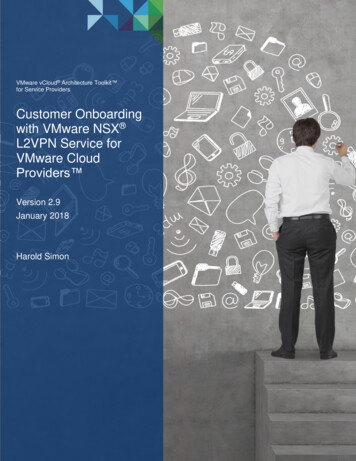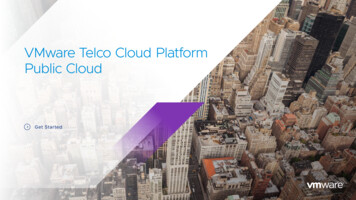
Transcription
VMware Telco Cloud PlatformPublic CloudGet Started
AbstractIntroductionMarket Overview and Driversof Current SP StrategyOperational ConstraintsBlocking the Realizationof New StrategiesThe Potential—andPotential Difficulties—of Public Cloud OptionMaking Public Cloud IaaSWork for SPs: VMware TelcoCloud Platform—Public CloudConclusion2Telecommunications service providers (SPs) are poisedto profit from new revenue opportunities from 5G andrelated services. However, SPs’ existing vertically scalable,on-premises infrastructure creates barriers to realizing theupside of 5G. Partnerships with public cloud hyperscalerslike Amazon Web Services (AWS) are promising but comewith a variety of constraints that may limit strategic flexibility.VMware Telco Cloud Platform —Public Cloud offersa solution. It enables SPs to take advantage of the bestattributes of on-premises telco cloud and public cloudinfrastructure as a service (IaaS) while preserving theability to migrate functions wherever the SP wantsthem to go.
IntroductionIntroductionMarket Overview and Driversof Current SP StrategyOperational ConstraintsBlocking the Realizationof New StrategiesThe Potential—andPotential Difficulties—of Public Cloud OptionMaking Public Cloud IaaSWork for SPs: VMware TelcoCloud Platform—Public CloudConclusion3Telecommunications SPs are at a unique strategic juncturein today’s marketplace. Opportunities abound, with 5Gand related services offering revenue growth as othercategories decline. However, existing methods of buildingand expanding on-premises/own infrastructure cannot keepup with the explosion of services and capture potentialopportunities created by 5G. As a result, SPs are exploringpartnerships with hyperscalers to accelerate their businessexpansion. SPs are also looking into utilizing the samehyperscalers to deliver and run modernized applicationsalongside network functions in order to streamline theirbusiness operations and increase efficiency.The option of migrating workloads to the public cloud doescome with a number of potential difficulties, however. Asscalable and flexible as public clouds may be, using themwithout clear objectives and strategies could lead to a lock-insituation with limited ability to migrate to other clouds or backto on-premises telco clouds. Interoperability with other cloudsis similarly narrow in scope. Variations in machine formatscreate a costly process of refactoring or re-architectingapplications after migration.VMware Telco Cloud Platform—Public Cloud offers a solution.Based on an integration with VMware Cloud on AWS, a jointlyengineered modern hybrid cloud serviced developed byVMware and AWS, it enables SPs to take advantage of thebest attributes of both on-premises telco cloud and publiccloud IaaS offered by AWS. At the same time, it preservesthe ability to migrate functions wherever the SP wants themto go.
IntroductionMarket Overview and Driversof Current SP StrategyOperational ConstraintsBlocking the Realizationof New StrategiesMarket Overview and Driversof Current SP StrategyAverage revenue per user (ARPU) is trending down as SPsroll out 5G networks and compete more intensely with oneanother. The pressure is on to stand out. The 5G shift alsocreates enticing new business opportunities. These includesupport for services like enhanced mobile broadband (eMBB),ultra-reliable and low latency communication (URLLC), andmassive machine-type communications (mMTC). Each ofthese can lead to sticky revenue sources from smart cities,telemedicine, Industry 4.0 and so forth.The Potential—andPotential Difficulties—of Public Cloud OptionMaking Public Cloud IaaSWork for SPs: VMware TelcoCloud Platform—Public CloudConclusion4The 5G shift createsenticing new businessopportunities.
IntroductionMarket Overview and Driversof Current SP StrategyOperational ConstraintsBlocking the Realizationof New StrategiesThe Potential—andPotential Difficulties—of Public Cloud OptionMaking Public Cloud IaaSWork for SPs: VMware TelcoCloud Platform—Public CloudConclusion5Operational Constraints Blocking theRealization of New StrategiesThe revenue opportunities are there, but they’re difficult tooperationalize. Here’s the problem: SPs have traditionallyinvested in monolithic, vertically integrated cloud stacks thatthey run on their own premises. These are generally designedto run vendor-specific virtualized and containerized networkfunctions. To be effective in business terms, though, SPs’cloud stacks must now be horizontal in nature. They haveto support any network function from any vendor. This isnot easy on a vertically integrated cloud stack.Additionally, the vertically integrated cloud stacks are moreexpensive to operate. They tend to lack consistency andlag in automation across network functions. This furthercomplicates service deployment and adds to cost. Theapplication of networking and security policies must beuniform and consistent regardless of network functionsand their respective deployment locations. An automatedmulti‑cloud architecture with global deployment is clearlypreferable but economically unrealistic for even thebiggest SPs.Inability to adapt and quickly seize businessAn SP’s existing infrastructure is almost always an obstacleto adapting to new customer requirements and movingquickly enough to seize business opportunities. The timeand financial commitment required to build horizontal cloudarchitectures can be prohibitive. When additional factors,like location and anticipated scaling up, are added intothe planning process, the difficulty becomes even moreconsiderable. As a result, SPs’ 5G services rollouts can slowdown. They are missing opportunities to enter new marketsand respond to higher demands, unless they want to makeenormous upfront investments.
Limits on data center constructionIntroductionMarket Overview and Driversof Current SP StrategyOperational ConstraintsBlocking the Realizationof New StrategiesThe Potential—andPotential Difficulties—of Public Cloud OptionMaking Public Cloud IaaSWork for SPs: VMware TelcoCloud Platform—Public CloudConclusion6Even if an SP has the intent to build a data center, barriersremain in the way. One issue is cost. Industry consensus isthat data center construction costs are trending upward,to around 10 million per megawatt or 200 million for a20-megawatt data center. That’s a lot of capital expense(CapEx). It then takes time to build, so SPs may miss earlyadopters and “first-mover advantage” scenarios that can beso beneficial to establishing new markets.Space and power are arguably more serious obstacles. Inmany cities, especially the major urban areas where SPs canlaunch the most lucrative 5G services, there simply isn’t thespace or electric available. Or, if the space is free, it will notbe easy to provision 20 megawatts of power. Permitting andthe like can also cause delays and headaches.Other considerations include operating expenses (OpEx)and capacity. Data centers are not cheap to operate,especially when capacity is taken into account. The natureof data center construction is such that an SP would be welladvised to over‑build so as to have the ability to scale upservice capacity without having to start a new constructionproject. This makes sense, but the overprovisioning inherentin the practice leaves the SP with the requirement to carrythe cost of running an underutilized data center for the firstseveral years of its operation.Data center construction costs are trending upward, toaround 10 million per megawatt.Limits on talent/slow hiring cyclesThen, there’s the matter of people. The United States, forexample, is in the midst of a labor shortage that is hittingthe tech sector with particular force. Qualified professionalsare getting hard to find. And, SPs are running into gaps inemployee skill sets as they take on new technologies likecontainers, edge computing and radio access network (RAN).An SP that wants to build a data center to support new 5Gservices may struggle to staff it.
IntroductionMarket Overview and Driversof Current SP StrategyOperational ConstraintsBlocking the Realizationof New StrategiesThe Potential—andPotential Difficulties—of Public Cloud OptionMaking Public Cloud IaaSWork for SPs: VMware TelcoCloud Platform—Public CloudThe Potential—and PotentialDifficulties—of Public Cloud OptionFacing these constraints, a natural strategic reaction is toembrace cloud hyperscalers like AWS, despite lingeringconcerns about competition for telco business from thesecompanies. Instead, both telcos and hyperscalers are comingtogether in a mode of “coopetition.” It’s impossible to knowhow these relationships will evolve over time, but for now itmakes a great deal of sense for AWS, Microsoft Azure andGoogle Cloud Platform (GCP) to work with SPs on 5GHow an SP can work with a hyperscalerHyperscalers like AWS offer SPs IaaS. The SP can configurethe infrastructure however it wants to support its IT and telcoworkloads. As shown in the reference architecture in Figure 1,the SP can build its infrastructure on IaaS, layer by layer.Certified NFs Harden and optimize throughrigorous integration testing.Modernized ApplicationsVNFVNFCNFCNFAPPAPP Transform applications with K8s. Directly access to AWS services. DevOps-ready platform and servicesempower IT.Telco Cloud OperationsWorkload PortabilityBusiness Flexibility As a Service Reduce costs and time of refactoringworkloads. Gain full control of the workloadswith the ability to bring them back.Telco Cloud AutomationVMware Cloud DirectorConclusionOn-Demand Capacity Scale capacity up/down with speedand ease. Improve the decision-makingprocess of infrastructure expansion.7services. There’s a natural synergy. The hyperscalers havethe capacity ready to go. The SPs have the brand name andexpertise in working with telco customers, which thehyperscalers lack.Figure 1: Reference architecture for how a telco can deploy on public cloud IaaS. Minimize infrastructure costs and risks. Align costs to the business needs toprotect investments.Tanzu Standard for TelcoTelco Cloud Infrastructurepowered by VMware Cloud on AWSPlatform Consistency Accelerate cloud migrations using thecommon platform across multi-cloud. Improve operational efficiency andproductivities.
IntroductionMarket Overview and Driversof Current SP StrategyOperational ConstraintsBlocking the Realizationof New StrategiesThe Potential—andPotential Difficulties—of Public Cloud OptionMaking Public Cloud IaaSWork for SPs: VMware TelcoCloud Platform—Public CloudConclusion8VMware Cloud on AWS serves as the consistent telco cloudinfrastructure. A virtualized infrastructure manager (VIM)lets the SP control and manage the horizontal consistentinfrastructure to deploy virtualized network functions (VNFs)while container as a service (CaaS) enables the SP to runcloud-native network functions (CNFs) and modernizedapplications. The SP can host what amounts to a limitless setof workloads on this stack. Automation facilitates economicalmanagement, while analytics allows for assurance in telcocloud operations.Benefits of this approach include: xtreme scale and geographic reachEAWS and the other major public cloud providershave immense scale and reach. They offeron-demand capacity. Their sites span theglobe with effectively unlimited capacity. Bypartnering with VMware and AWS, an SP caninstantiate a wide array of 5G and related telcoservices in almost any region of the world atany required scale and scope. lexibilityFThe ability to make quick changes in configurationor software is the essence of public cloud IaaS. Bydeploying their network functions and modernizedapplications on VMware Telco Cloud Platform—Public Cloud, SPs gain a great deal of flexibility—along with the potential to align costs with businessneeds. The SP can scale IaaS resources up anddown as needed, such as with a seasonal orepisodic spikes (e.g., a major sporting event thatrequires a lot of connectivity for one day), butthen nothing the next day. ow/no CapExLVMware Cloud on AWS is based on an OpExmodel. The SP pays for the resources it uses andnothing else. There is not CapEx for infrastructure.The only CapEx would be for software licenses. ewer personnel issuesFVMware employees manage the infrastructure,so the SP does not have to recruit and retain asmany specialized people. The SP can focus onthe business growth by just operating thetelco cloud itself.
Potential problems with public clouds for SPsIntroductionMarket Overview and Driversof Current SP StrategyOperational ConstraintsBlocking the Realizationof New StrategiesThe Potential—andPotential Difficulties—of Public Cloud OptionMaking Public Cloud IaaSWork for SPs: VMware TelcoCloud Platform—Public CloudConclusion9The advantages of migrating telco workloads to the publiccloud notwithstanding, a number of potential problems stillloom for SPs that want to use public cloud IaaS offeringsfrom hyperscalers. One issue is provider lock-in. Oncedeployed on a public cloud, it may be challenging to movethe telco workloads to another public cloud IaaS. It won’t beimpossible, but barriers to migration can be significant. TheSP risks getting stuck. The lock-in scenario does not bodewell for bringing network functions back to SP-ownedon-premises infrastructure, either.Migrating network functions to public cloud IaaS mayalso result in the creation of cloud silos. Without theright tooling, each public cloud IaaS will require separateoperations. Network and security policies may differ fromcloud to cloud. Furthermore, the SP will almost certainly lackautomation capabilities that span multiple public clouds. Asthis unfolds, the SP might have pockets of network functionsrunning inefficiently, each vulnerable to different threats.Operability between public cloud IaaS is typicallylimited as well. And, while it is always possible to establishintegrations between telco stacks on different IaaS platforms,that is not always an optimal approach. The integrationbecomes another bit of technical debt to deal with,something to manage and update over time.A further issue arises from differences in machine formatsfrom on-premises telco cloud to public cloud or from onepublic cloud to another. If customers want to migrate networkfunctions and modernized applications between platforms,they will invariably need to refactor or re-architect them.Different tools and skill sets prevail across hybrid cloud/multi‑cloud environments, along with disparate managementtools and security and governance policies. Coping with thesedifferences leads to increases in time, costs and risks inmigration projects.
IntroductionMarket Overview and Driversof Current SP StrategyMaking Public Cloud IaaS Work forSPs: VMware Telco Cloud Platform—Public CloudVMware has endeavored to solve these problems and makepublic cloud IaaS a viable option for SPs. The VMware TelcoCloud Platform—Public Cloud enables SPs to modernize theirnetworks by seamlessly incorporating public cloud IaaS as anintegral part of their 5G architecture. The solution isone element of VMware’s broader cloud-smart approach,which is all about giving organizations the freedom to choosethe right cloud based on their strategic business goals. It’s acloud‑agnostic approach that transcends the more abstractconcepts of cloud-first or multi-cloud. Cloud-smart helpsVMware customers establish cloud strategies that areuniquely suited to their business needs.Operational ConstraintsBlocking the Realizationof New StrategiesThe Potential—andPotential Difficulties—of Public Cloud OptionMaking Public Cloud IaaSWork for SPs: VMware TelcoCloud Platform—Public CloudConclusionMulti-Cloud SolutionVMware SDDC Deployedas a Cloud ServiceAgility, Speed and Scale for 5G DeploymentsVMware vSphere VMware Telco CloudOperationsVMware NSX VMware Telco CloudAutomationVMware vSAN VMware Tanzufor TelcoVMware Telco Cloud Platform—Public CloudVMware HCX10VMware TelcoCloud PlatformConsistent Operations Across Multi-Cloud EnvironmentsFigure 2: Elements of VMware Telco Cloud Platform—Public Cloud.VMware Telco CloudInfrastructure
IntroductionMarket Overview and Driversof Current SP StrategyOperational ConstraintsBlocking the Realizationof New StrategiesThe Potential—andPotential Difficulties—of Public Cloud OptionMaking Public Cloud IaaSWork for SPs: VMware TelcoCloud Platform—Public CloudVMware Telco Cloud Platform—Public Cloud is powered byVMware Cloud on AWS, a field-proven solution, delivered,operated and supported by VMware. VMware Cloud on AWSfunctions as the consistent telco cloud infrastructure withVMware vSphere for compute virtualization, VMware NSXfor networking and security, VMware vSAN for storage andVMware HCX for application migration. Figure 3 shows thearchitecture of VMware Cloud on AWS, which allows SPs todirectly access AWS native applications. This enables SPsto improve the services and customer experiences they offer.On this foundation, VMware Telco Cloud Platform—PublicCloud offers telco-centric functionalities that support bothVNFs and CNFs, along with cloud-smart automation. Theresult is to simplify telco multi-cloud operations, analyticsand intelligence to maintain telco-grade service qualityand availability.The result is to simplify telco multi-cloudoperations, analytics and intelligence tomaintain telco-grade servicequality and availability.VMware and Third-Party ISV EcosystemvRealize , Tanzu Mission Control ManagementvSphere-BasedEnvironmentvCenterVMware Cloud on AWSAWS ServicesPowered by VMware Cloud FoundationvCenterTanzu ServicesTKG TMCEssentialsvSpherevSANS3NSXELB CodeBuild KMSConclusionVMware HCX Large-Scale MigrationCustomer DataCenter11Lambda Redshift AWS Global InfrastructureFigure 3: VMware Cloud on AWS, the core of VMware Telco Cloud Platform—Public Cloud.
IntroductionMarket Overview and Driversof Current SP StrategyOperational ConstraintsBlocking the Realizationof New StrategiesThe Potential—andPotential Difficulties—of Public Cloud OptionMaking Public Cloud IaaSWork for SPs: VMware TelcoCloud Platform—Public CloudConclusion12Getting the benefits of AWS for SPs,without the difficultiesSPs gain several advantages from this architecture. For onething, it offers them virtually limitless scale on-demand. Then,with VMware Telco Cloud Platform—Public Cloud, the SP canmake public cloud IaaS a natural extension of their existingon-premises infrastructure if it’s running the VMware TelcoCloud Platform. SPs get full operational consistency with anon-premises telco cloud, but one that takes advantage ofAWS’s global footprint and reach.The SP can easily migrate telco and IT workloads to publiccloud IaaS—and migrate them back whenever they want.They can go in both directions relatively quickly, easily andcost‑effectively by having the consistent infrastructure in bothclouds. Applications do not have to refactored in order tomigrate from one cloud to another due to this consistency.Furthermore, the SPs can use the same tools, skill sets andgovernance and security policies as they switch fromon-premises telco cloud to public cloud IaaS. The abilityto achieve a multi-cloud capability, with migration betweenAWS and other public cloud IaaS, is in development.The flexible capacity made possible by the on-premises/publiccloud IaaS combination lets SPs rapidly adjust cloud capacity.The SP can respond to peaks and valleys in demand andresulting changes in traffic patterns, adapting easily tochanging business needs and customer demands.The SP can leverage full visibility of platform status toprogrammatically adjust platform resources based on workloadlocation. Use cases include cloud bursting/scaling, disasterrecovery and high availability, all done without overprovisioningon-premises telco cloud. The same workload performance canbe maintained between on-premises telco cloud and publiccloud IaaS.VMware Telco Cloud Platform—Public Cloud addressesthe problem of operational inconsistencies, too. There is justone management tool set and one group of security controlsthat apply to on-premises telco cloud and public cloud IaaS.Multilayer automation allows the SP to manage its telco cloudinfrastructure to be efficient in managing elements of its telcocloud across all instances. And, the consistent tool set meansalmost no retraining of staff as workloads move back and forthfrom the public cloud.A further benefit arises from the ability torun CNFs alongside modern applicationson VMware Tanzu, allowing the SPsto modernize their 5G networks.On top of this, the SP is able toenrich customer experienceby directly accessing morethan 200 nativeAWS services.
ConclusionIntroductionMarket Overview and Driversof Current SP StrategyOperational ConstraintsBlocking the Realizationof New StrategiesThe Potential—andPotential Difficulties—of Public Cloud OptionMaking Public Cloud IaaSWork for SPs: VMware TelcoCloud Platform—Public CloudConclusion13The telecom industry finds itself at a crossroads. A host ofmajor revenue opportunities are at hand, which is goodbecause traditional lines of businesses are flattening orshrinking. Getting to success with 5G and related technologieswill mean deploying telco clouds with new, horizontalarchitectures on a vast scale—a mandate that is at oncecostly and slow to realize.One solution, which SPs are increasingly consideringdespite competitive concerns, is to partner with publiccloud hyperscalers. These companies have the capacity andgeographic reach. They make CapEx unnecessary. However,they also present a number of challenges, such as thepotential for lock-in and inefficient, inconsistent operation.VMware Telco Cloud Platform—Public Cloud makes publiccloud IaaS into a viable option for SPs. The platform lets SPsmigrate telco and IT workloads to public cloud providerslike AWS and also migrate them back to on-premises telcoclouds when necessary. The management is seamless andcontiguous across owned and public cloud instances. As aresult of these capabilities, SPs gain the ability to deliverrapid time to value and accelerate time to market for new5G services—entering new markets without having toincur upfront infrastructure costs and risks.SPs gain the ability to deliverrapid time to value andaccelerate timeto market fornew 5G services.
Figure 1: Siag niti coraaccabo.Get Started TodayRealize your multi-cloud vision.Join us online:LEARN MORECopyright 2022 VMware, Inc. All rights reserved. VMware, Inc. 3401 Hillview Avenue Palo Alto CA 94304 USA Tel 877-486-9273 Fax 650-427-5001VMware and the VMware logo are registered trademarks or trademarks of VMware, Inc. and its subsidiaries in the United States and other jurisdictions. All other marks and names mentioned herein may be trademarks of their respective companies.VMware products are covered by one or more patents listed at vmware.com/go/patents. Item No: VMW-SO-TELCO-CLOUD-PUBLIC-26 67x15-101 01/22
VMware Telco Cloud Platform—Public Cloud offers a solution. Based on an integration with VMware Cloud on AWS, a jointly engineered modern hybrid cloud serviced developed by VMware and AWS, it enables SPs to take advantage of the best attributes of both on-premises telco cloud and public cloud IaaS offered by AWS. At the same time, it preserves


